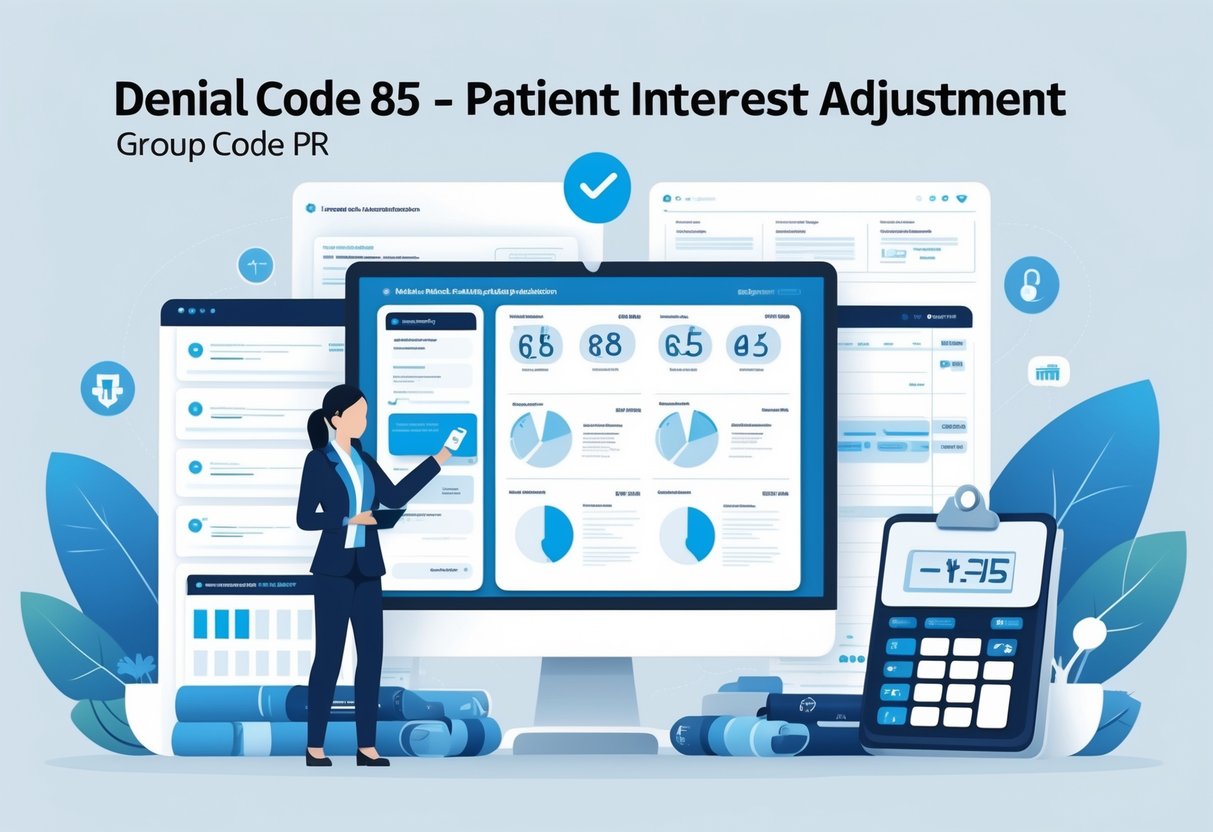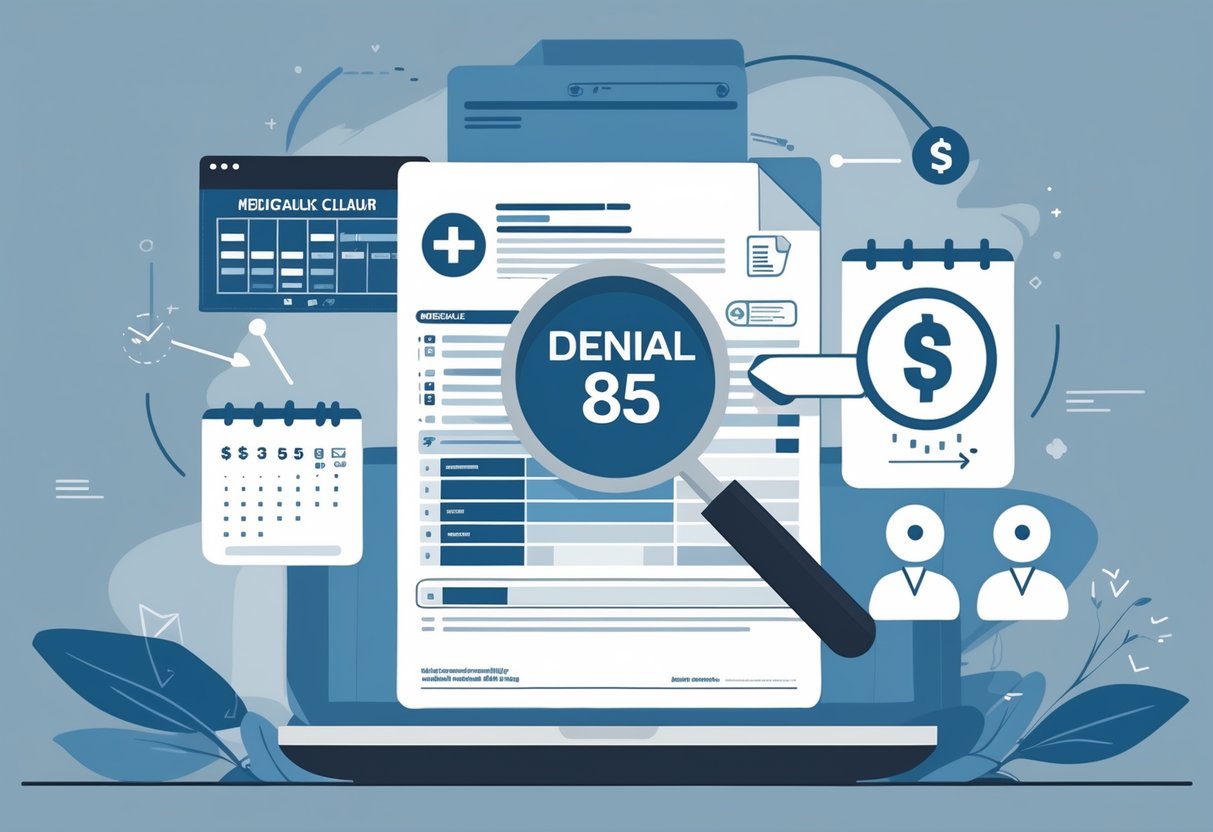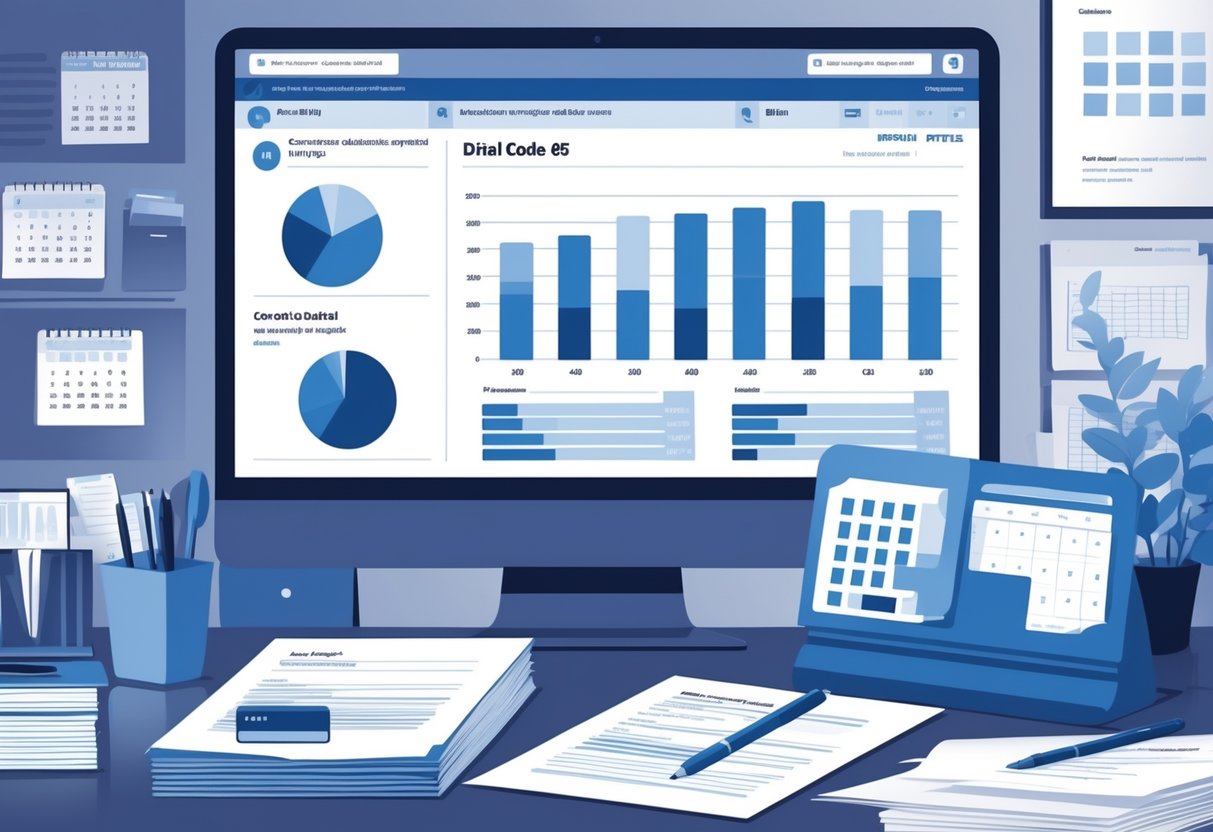Denial code 85 means there was a Patient Interest Adjustment, and you should only use Group code PR to handle this. This code tells you the adjustment is related to the patient’s financial responsibility, not the insurance provider’s. Understanding this helps you manage billing issues correctly.
When you see denial code 85, it usually involves interest charged on the patient’s balance. Knowing how to use the correct group code prevents errors in your claim processing. This keeps your accounts accurate and helps you avoid delays in payment.
Understanding Denial Code 85 – Patient Interest Adjustment (Use Only Group code PR)

Denial code 85 relates to adjustments made for patient interest amounts in billing. It involves specific rules for applying patient responsibility edits using group code PR. This ensures accurate communication about what costs the patient must pay.
Definition and Key Concepts
Denial code 85 signals an adjustment called the Patient Interest Adjustment. This means the amount changed depends on interest charges linked to patient billing.
You must only use Group Code PR with this denial code. PR stands for Patient Responsibility, pointing out the part the patient owes after adjustments.
This code is not for insurance payments or other administrative errors. It strictly refers to interest applied on patient balances, usually when payments are late or partial. Using denial code 85 correctly helps keep patient billing clear and accurate.
Purpose of the Denial Code
The main purpose of denial code 85 is to notify that an adjustment was made because of interest charged to the patient. It shows that the patient owes more or less due to interest calculations.
For example, if your billing system adds interest on overdue amounts, this denial code flags that adjustment. It prevents confusion between interest charges and other fee types like copays or deductibles.
Using this code ensures that all parties understand why the patient’s payment amount changed. It also keeps the billing process transparent and compliant with billing rules that require clear coding of patient interest adjustments.
Common Scenarios for Use
You will often see denial code 85 when interest is charged on late patient payments. For example, if a patient delays payment past a set due date, interest may be added to their balance.
This code can also apply when you correct a previous undercharge or overcharge related to interest on the patient’s account. It’s only for adjustments impacting the amount the patient is responsible to pay directly.
Avoid using this code for insurance denials or when adjusting fees unrelated to patient interest charges. Proper use helps maintain accurate records and limits disputes about patient balances when interest is involved.
Causes and Triggers for Denial Code 85

Denial Code 85 arises when adjustments are made to patient balances based on interest or payment responsibilities. It involves specific billing roles and requires precise use of Group code PR for proper processing.
Patient Responsibility in Billing
You may see Denial Code 85 when the patient owes a balance after insurance pays its share. This could be due to copayments, deductibles, or coinsurance amounts that are the patient’s responsibility.
When you bill, the part the patient must pay is tracked and adjusted separately. If the patient’s portion is incorrect or needs adjustment, this denial code reflects that change.
Your billing system uses this code to show the adjustment relates only to the patient’s financial responsibility, not the insurer’s. It keeps your accounts clear on who owes what.
Manual and Automated Adjustments
Denial Code 85 can result from both manual and automated adjustments to patient balances. You might manually update accounts when resolving disputes or correcting errors.
Automated systems can also trigger this denial when interest adjustments apply after a set time if payments are late. These built-in processes help keep billing accurate without constant manual review.
In either case, the adjustment must only affect amounts owed by the patient, respecting the rules set by the payer and your billing policies.
Role of Group Code PR
Group code PR is essential when using Denial Code 85. You must apply this code to denote that the adjustment is purely for Patient Responsibility.
Using any code other than PR causes billing errors and rejection by insurers. The PR code shows clear separation between patient adjustments and insurer obligations.
When submitting claims or explanations, always check that Denial Code 85 pairs with Group code PR. This compliance prevents confusion and ensures proper handling of the adjustment.
Impacts on Healthcare Providers and Patients
Denial code 85 affects both your practice’s finances and patient experience. You also need to change how your team communicates with patients and handles billing. These shifts require clear steps to prevent confusion and financial loss.
Financial Consequences
Denial code 85 means certain charges get adjusted due to patient interest responsibilities. This can lower the amount your practice collects right away. You might see delays in payments or have to follow up more aggressively.
Your revenue cycle can slow down as you track and manage these adjustments. You will need to budget for potential cash flow changes. Not handling these denials correctly could lead to larger financial gaps.
Tracking denials under group code PR helps you identify trends. This insight lets you address issues before they affect your income too much.
Patient Communication Strategies
When you use denial code 85, your patients might get unexpected bills or statements. It’s important to explain these adjustments clearly to avoid confusion or complaints.
You should prepare simple, direct messages about why the patient owes more. Use easy-to-read letters or emails outlining the interest adjustment and steps to resolve it.
Training your staff to answer patient questions helps reduce frustration. You can also provide self-service options through online portals for quick account checks.
Clear communication reduces disputes and supports timely payments, protecting your relationship with your patients.
Provider Workflow Adjustments
Handling denial code 85 requires changes to your billing and claims processes. Your team should update workflows to flag and manage these interest adjustments efficiently.
You may need to create specific task lists or use software alerts to track denials with group code PR. This ensures no adjustment is missed or mishandled.
Regular staff training on this denial code is essential. It helps everyone understand when and why to apply patient interest adjustments.
Integrating these changes into daily operations improves accuracy and speeds up resolution times. This keeps your revenue cycle steady.
Denial Management and Resolution Strategies
To handle denial code 85 effectively, you need clear steps for appeals, proper documentation, and ways to prevent this denial altogether. Each of these parts plays a key role in resolving the issue quickly and avoiding future problems.
Appeal Processes
When you get a denial with code 85, start by reviewing the payer’s explanation of benefits (EOB) carefully. The denial means the patient’s interest adjustment was not accepted, so you must check if the claim was coded with the right group code PR.
File an appeal with the insurance company following their set timeline, often 30 to 60 days. Include a clear letter explaining why the denial was wrong. Highlight any payment already made by the patient and back it up with billing records.
Make sure to track your appeal status actively. Keep copies of all correspondence and follow up regularly to ensure your appeal is reviewed on time.
Documentation Requirements
Accurate documentation is critical when addressing denial 85. You must provide proof of the patient’s payments and any interest adjustments already applied. Include patient statements, payment receipts, and detailed billing statements in your records.
Ensure the claim form uses group code PR when indicating patient responsibility adjustments. Missing or incorrect codes are common reasons this denial happens.
Keep a record of any communication with the patient about charges and payments. These documents help prove the validity of your claim during an appeal or audit.
Best Practices for Prevention
To prevent denial code 85, verify the patient’s account balance and payment history before submitting claims. Use the correct group codes consistently—especially group code PR for patient interest adjustments.
Set up routines to double-check claim forms for accuracy before submission. Train billing staff on denial code meanings and proper coding rules.
Monitor your claims regularly to spot trends in denials early. Use software alerts or reports to catch errors before claims are sent. This reduces delays and improves your payment process.
Regulatory Considerations and Compliance
You must follow specific healthcare rules and standards when using denial code 85 for patient interest adjustments. These rules ensure correct reporting and help avoid claim rejections or legal issues.
Relevant Healthcare Policies
Denial code 85 falls under Group Code PR, which relates to patient responsibility adjustments. You need to confirm that the adjustment matches the patient’s financial agreement or insurance policy terms.
Policies from CMS (Centers for Medicare & Medicaid Services) and private payers require accurate documentation for any patient interest applied. Without proper records, your claim can be denied or audited.
Use consistent communication with payers and patients about interest charges. This helps prevent confusion and supports compliance with the Fair Credit Billing Act and other billing regulations.
Reporting and Audit Standards
When you use denial code 85, your reporting must be precise. You should document every adjustment detail, including dates, amounts, and the reason for the interest charge.
Auditors focus on whether your interest adjustments reflect true patient agreements and follow payer rules. An error in reporting can lead to claim denials or repayment demands.
Keep your internal records organized and up to date. Use software or tools that track all patient interest adjustments and support easy audit responses.
| Key Points | Actions Required |
|---|---|
| Accurate documentation | Maintain clear, dated records |
| Compliance with payer rules | Follow CMS and private payer rules |
| Prepare for audits | Keep organized, accessible files |
Frequently Asked Questions
You will find details about when and how denial code 85 should be applied. This includes the types of insurance carriers it covers, the needed documents, effects on patient balances, and specific reporting rules linked to the PR group code.
What is the correct application of denial code 85 for patient interest adjustments?
Denial code 85 is used only to adjust patient interest amounts. You must use the PR group code when applying this denial. It should reflect changes in the patient’s financial responsibility.
Can denial code 85 be used for both private and government insurance carriers?
Yes, you can use denial code 85 for both private and government payers. The key is that the adjustment always involves patient interest. The code does not apply to insurer responsibility.
What documentation is required when processing adjustments under denial code 85?
You need documentation that clearly shows the patient interest charges. This might include billing statements or interest calculation sheets. Proper records ensure accurate adjustments and auditing.
How does denial code 85 affect patient balance and billing statements?
Denial code 85 reduces or adjusts the patient’s balance by the interest amount. Your billing statements should reflect this adjustment so that patients see the correct amount owed. It prevents overcharging.
Are there specific guidelines for reporting PR (patient responsibility) under denial code 85?
Yes, you must report denial code 85 only with the PR group code. This signals that the adjustment concerns patient responsibility. Using other group codes may cause claim processing errors.
What are the common reasons for which denial code 85 would be applied to a claim?
Common reasons include correcting interest overcharges or removing interest when waived. You apply denial code 85 to fix errors related to patient interest amounts on bills. This keeps patient accounts accurate.







